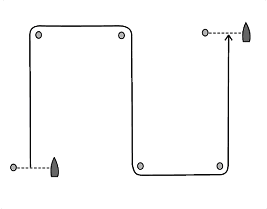Team racing in sailing can often be seen as this ominous task that’s only meant for really experienced sailors. Many times, it is misunderstood and this huge complicated idea which involves thousands of playbooks and rules. However, I firmly believe that anyone who wants to can learn and that it happens to be one of the most enjoyable sailing opportunities there is. Simply imagine this…
At the basic level, it is just another sailboat race. You’re out on the water racing and just like any race, it’s really important to go fast. In fact, it is so important to apply your regular racing skills that you can win a lot of these simply keeping your boat moving.
Now imagine that you’re on a team with 2 other people racing against another team who also has 3 people. The score is simply calculated by adding up both teams placings and seeing who as the least score. This means, that if every person of your team is each beating a member of the opposite team, you win! The end result of all this is that the team race starts out as 3 individual match races which your team needs to win the majority of to win. But what if you’re not winning?
This is where it starts to get interesting, and we start to get into the playbooks I was talking about at first. However, it is still important to remember that this might not apply if you and your team are good enough to just beat the other team. Anyways, these plays simply consist of the idea that you are on a team, and can help each other out. The very principle of a play is that you can help your teammate out, without losing your own position. This typically happens as a mark when everyone compresses (mark trap) but can also if needed happen at any other point during the race (passback). I’ve listed below some of the most common and easy to explain, make sure to remember this basic strategy, what follows is just icing on the cake.
Mark Traps and Passbacks:
To start, let’s talk about the course (pictured below). Sailors typically number the marks, and it is important to make sure that your entire team knows which order the marks are in because a mark-1 marktrap looks a lot different than a mark-2 passback. Most teams number the marks in the order that you round them in, i.e the top left is mark-2 and the bottom right is mark-4). Conversely, legs (the lines between the marks) are numbered in the order you round them as well, meaning that on the leftmost vertical line, your team would perform a leg-1 passback. Enough about numbering let’s get to the top 3 traps and passbacks.

- Mark-1 marktrap (top right mark)
- This trap is usually the first one to be executed, and consists of 3 people, A1 (the person helping his team), A2 (the person being helped), and B (the opposite team). Typically for this to work, the order needs to be A1, B, A2, and A1 needs to be set up on starboard tack at the mark. From then on, A1 needs to stop B and will do this by either heading up B past the mark or making him tack and sail away. From then A2 swings inside, A1 releases and B rounds last out of the three.’
- Mark-3 marktrap (middle bottom mark)
- This trap is run a lot like the mark-1 marktrap, except for just on the downwind. A1, A2, and B all are the same, have to round in the same order, and A1 needs to be set up at the mark on starboard. Once A1 is set up, B has two choices: he can either round behind A1 and miss the mark, or in front of him and get headed up, at which point A2 round the mark, A1 releases, and B rounds last.
- Leg-4 Passback.
- This passback typically is used as a last-ditch effort if a team is loosing and something needs to be done on the last leg. This means that even though it is one of the hardest to execute, it gets used almost every race because 1 team must be loosing. We will use the same naming and order notation as the plays above. It starts by A1 swopping in from above on B, it is important that A1 is not too close (otherwise B can call a foul) or too far away (otherwise this doesn’t work). Once A1 is in position, the boat will luff their jib and pull their sail over their head. If executed correctly A1 ends up stopping himself and B, while A2 passes. When A1 releases A2 is in front of him and B, and B is in last.
These three are just the tip of the iceberg, there are many many more plays. I encourage you that if you enjoyed this article to take a look at team racing and see if you like it. If you are already a team racer then I hope this helped with some basic understanding. Feel free to leave comments below if you would like to know more or have a specific question. Most important have fun and sail on!
